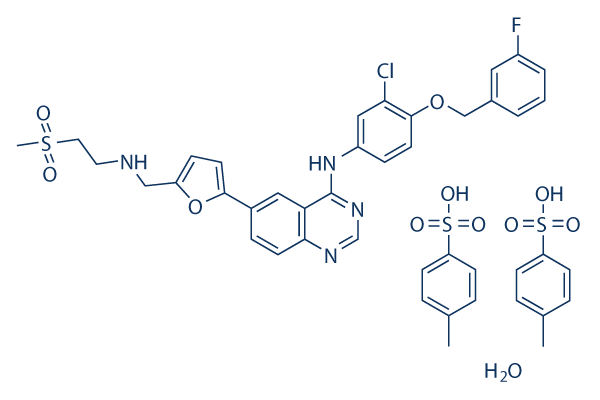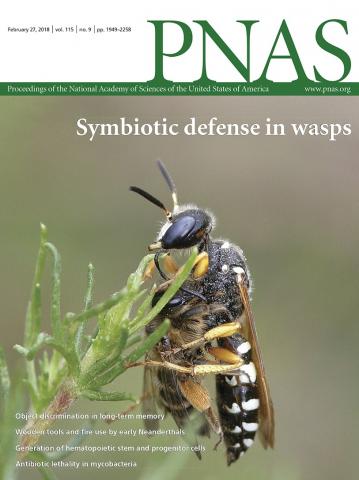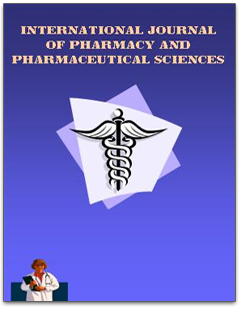All AbMole products are for research use only, cannot be used for human consumption.

Lapatinib ditosylate monohydrate (GW572016 ditosylate monohydrate) is a potent inhibitor of the ErbB-2 and EGFR tyrosine kinase domains with IC50 values against purified EGFR and ErbB-2 of 10.2 and 9.8 nM, respectively. Lapatinib (GW2016; 0.03-10 µM; 6 hours; BT474 and HN5 cells) treatment inhibits receptor autophosphorylation of EGFR and ErbB-2 in a dose-responsive manner. Phosphorylation of serine 473 of AKT was inhibited by GW2016 in a dose-dependent manner.
ErbB-2 and EGFR dual tyrosine kinases are growth promoting factors that are over expressed in some breast cancer cell lines. Lapatinib inhibits the growth of both EGFR- and ErbB-2-overexpressing cells, whereas OSI-774 and Iressa which are EGFR selective inhibitors preferentially inhibit the growth of the EGFR-overexpressing cell lines. Research studies have reported that Lapatinib Ditosylate can inhibit breast cancer cell proliferation.

Cell Death Dis. 2021 Feb 15;12(2):179.
Targeting transcription of MCL-1 sensitizes HER2-amplified breast cancers to HER2 inhibitors
Lapatinib ditosylate monohydrate purchased from AbMole

Proc Natl Acad Sci U S A. 2018 Feb 23.
Coamplification of miR-4728 protects HER2-amplified breast cancers from targeted therapy
Lapatinib ditosylate monohydrate purchased from AbMole

J Pharm Pharm Sci. 2016 Feb;404-407.
Phase dependent discrepancy in murine vaginal micro-environment: A correlative analysis of PH, glycogen and Serum Estrogen upon exposure to Lapatinib Ditosylate
Lapatinib ditosylate monohydrate purchased from AbMole
| Cell Experiment | |
|---|---|
| Cell lines | HFF; BT474, MCF-7, N87, and CaLu-3; HN5, A-431, T47D, HB4a, and HB4a c5.2 cell lines |
| Preparation method | In Vitro Growth Inhibition Assays For assessment of cell-based potency, cells were plated in 96-well Falcon plates (Becton Dickinson) in the growth media described above. Plating densities that resulted in logarithmic growth of vehicle-treated cells for the duration of the assay were used: HFF, 15,000 cells/cm2; BT474, MCF-7, N87, and CaLu-3, 30,000 cells/cm2; and HN5, A-431, T47D, HB4a, and HB4a c5.2, 10,000 cells/cm2. After 24 h, cells were exposed to compounds at the concentrations indicated in Fig. 2. HFF, BT474, HN5, and N87 cells were treated in low-glucose DMEM containing 5% FBS, 50 μg/ml gentamicin, and 0.3% v/v DMSO. MCF-7 cells were treated in 50% high-glucose DMEM, 50% low-glucose DMEM containing 5% FBS, 50 μg/ml gentamicin, and 0.3% v/v DMSO. T47D, A-431, and CaLu-3 cells were treated in 50% RPMI, 50% low-glucose DMEM containing 5% FBS, 50 μg/ml gentamicin, and 0.3% v/v DMSO. HB4a and HB4a c5.2 cells were treated in 50% DMEM, 50% RPMI 1640 supplemented with 5% FBS, 2.5 μg/ml hydrocortisone, 2.5 μg/ml insulin, 25 μg/ml hygromycin B, 50 μg/ml gentamicin, and 0.3% v/v DMSO. After 3 days, relative cell number was estimated using methylene blue staining. The media were removed, and 100 μl of 0.5% w/v methylene blue dissolved in 50% ethanol and 50% water were added to each well. Plates were washed by immersion in deionized water and allowed to air dry. 1% w/v n-lauroylsarcosine (100 μl) dissolved in PBS was added to each well, and plates were incubated for 30 min at room temperature. The absorbance at 620 nm was read in a Spectra (Tecan) microplate reader. Data were analyzed using curve-fitting macros written for Microsoft Excel. Concentrations with IC50 were interpolated using the method of Levenberg and Marquardt and this equation: y = Vmax × [1 − (xn/(Kn + xn))], where “K” is equal to IC50. |
| Concentrations | 0~100 μM |
| Incubation time | 3 days |
| Animal Experiment | |
|---|---|
| Animal models | CD-1 nude female mice were used for HN5 human tumor xenografts, C.B-17 SCID female mice were used for BT474 human tumor xenografts |
| Formulation | sulfo-butyl-ether-β-cyclodextrin 10% aqueous solution (CD10) |
| Dosages | 30 or 100 mg/kg twice daily for 21 days |
| Administration | p.o. |
| Molecular Weight | 943.48 |
| Formula | C43H44ClFN4O11S3 |
| CAS Number | 388082-78-8 |
| Solubility (25°C) | DMSO 60 mg/mL |
| Storage | -20°C, dry, sealed |
| Related EGFR/HER2 Products |
|---|
| Depatuxizumab
Depatuxizumab is a brain-penetrant and humanized tumor-specific anti EGFR monoclonal antibody. Depatuxizumab inhibits the growth of xenograft models of mutant EGFRvIII and wild-type EGFR. |
| Sevabertinib
Sevabertinib is an epidermal growth factor receptor (EGFR) tyrosine kinase inhibitor with antitumor activity. |
| BPIQ-I
BPIQ-I (PD 159121) is a potent and ATP-competitive EGFR tyrosine kinase inhibitor.. |
| HKI-357
HKI-357 is an irreversible dual inhibitor of EGFR and ERBB2 with IC50s of 34 nM and 33 nM, respectively. |
| SJF-1528
SJF-1528 is a potent EGFR PROTAC degrader with DC50 values of 39.2 nM and 736.2 nM for wild-type EGFR in OVCAR8 cells and Exon 20 Ins mutated EGFR in HeLa cells. |
All AbMole products are for research use only, cannot be used for human consumption or veterinary use. We do not provide products or services to individuals. Please comply with the intended use and do not use AbMole products for any other purpose.


Products are for research use only. Not for human use. We do not sell to patients.
© Copyright 2010-2024 AbMole BioScience. All Rights Reserved.
